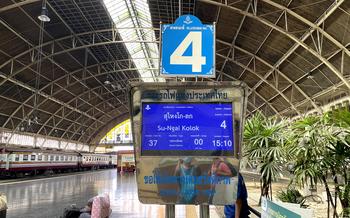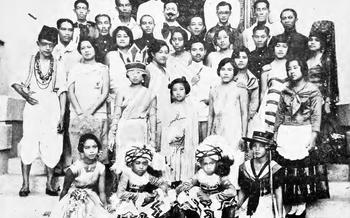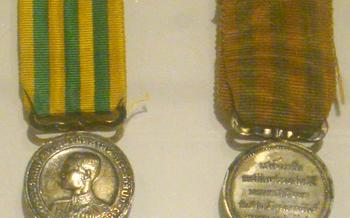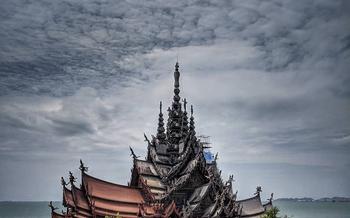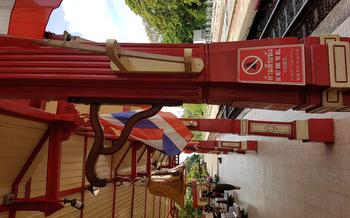
King Rama VI Military Camp Historical Park
- King Rama VI Military Camp Historical Park: A Historical Overview
- Exploring the Camp's Main Attractions
- Unveiling the Military Museum's Treasures
- Witnessing the Changing of the Guard Ceremony
- Taking a Stroll through the Verdant Gardens
- Discovering the History of the Royal Pavilion
- Learning about the Camp's Role in World War II
- Exploring the Camp's Fortifications
- Admiring the Camp's Architectural Heritage
- Engaging with Interactive Exhibits and Displays
- Understanding the Camp's Role in Modern Thailand
- Capturing Memorable Photographs
- Insider Tip: Unveiling Hidden Gems
King Rama VI Military Camp Historical Park: A Historical Overview
The King Rama VI Military Camp Historical Park holds a significant place in Thailand's military history, dating back to the reign of King Rama VI, also known as King Vajiravudh. The camp was established in 1909 as a military training ground and served as the headquarters for the Royal Thai Army's 14th Infantry Division. During King Rama VI's reign, the camp played a crucial role in modernizing and strengthening the Thai military, emphasizing military training and discipline. The site's historical significance lies in its representation of King Rama VI's vision for a modern and efficient military force capable of defending the nation. Today, the camp stands as a testament to Thailand's military heritage and serves as a valuable reminder of the country's efforts to maintain its sovereignty and independence. The park's preservation ensures that future generations can appreciate and learn from this important chapter in Thailand's history.
Exploring the Camp's Main Attractions
The King Rama VI Military Camp Historical Park encapsulates a plethora of captivating attractions that immerse visitors in its rich history and grandeur. The heart of the park lies in the resplendent royal pavilion, a testament to King Rama VI's architectural vision. Inspired by traditional Thai and European styles, the pavilion served as a royal residence and military headquarters during the monarch's reign. Its intricate carvings, opulent furnishings, and regal ambiance transport visitors back in time.
Beyond the royal pavilion, the park showcases a diverse array of notable buildings, monuments, and artillery displays. Visitors can marvel at the majestic throne hall, where King Rama VI conducted official ceremonies and received foreign dignitaries. The camp's impressive collection of artillery pieces, including cannons and mortars, provides a glimpse into the military might of the era.
The scenic landscape and natural surroundings of the park further enhance its allure. Lush gardens adorned with vibrant tropical flowers and towering trees create a tranquil oasis amidst the historical landmarks. Visitors can stroll along meandering paths, soak in the serene atmosphere, and relish the beauty of nature.
Unveiling the Military Museum's Treasures
The King Rama VI Military Camp Historical Park houses a captivating military museum that showcases a wealth of artifacts and exhibits, providing visitors with an immersive journey into the camp's rich military history. Among the highlights of the museum's collection are meticulously preserved weapons and equipment used by the camp's soldiers throughout the years. Visitors can marvel at an array of firearms, including rifles, pistols, and machine guns, each with its own unique story to tell.
Beyond weaponry, the museum also houses a collection of historical documents, photographs, and personal belongings that shed light on the daily lives and experiences of the camp's personnel. Visitors can peruse through old military maps, uniforms, and medals, gaining insights into the camp's military operations and the sacrifices made by its soldiers. Interactive displays and educational resources further enhance the museum experience, allowing visitors to engage with the exhibits and learn more about the camp's history in a dynamic and interactive manner.
Witnessing the Changing of the Guard Ceremony
The King Rama VI Military Camp Historical Park offers visitors a glimpse into the rich military traditions of Thailand through its awe-inspiring Changing of the Guard Ceremony. This ceremonial parade is a testament to the discipline, precision, and regality that define the Thai military.
Held daily at the main parade ground within the park, the ceremony showcases the meticulous changing of the guard duties, accompanied by a harmonious blend of music, drill movements, and colorful uniforms. The guards, dressed in their finest attire, march in perfect synchrony, displaying their unwavering dedication to their roles.
Visitors are invited to witness this spectacle from designated viewing areas, capturing the grandeur of the ceremony as the guards exchange their positions with impeccable precision. The parade is not just a visual feast but also a symbolic reminder of the camp's historical significance and the unwavering commitment of its personnel to their duty.
To ensure a memorable experience, visitors are advised to arrive early to secure a good viewing spot and witness the ceremony from start to finish. Respectful behavior and silence are expected during the parade to maintain the solemnity of the occasion.
The Changing of the Guard Ceremony at the King Rama VI Military Camp Historical Park is a must-see attraction for anyone interested in military history, cultural traditions, and the vibrant spirit of Thailand. It is a unique opportunity to witness the ceremonial precision and dedication that have become synonymous with the Thai armed forces.
Taking a Stroll through the Verdant Gardens
Amidst the historical structures and military artifacts, the King Rama VI Military Camp Historical Park boasts a serene oasis in the form of its verdant gardens. These botanical havens offer a tranquil escape for visitors seeking respite from the rigors of exploration.
The gardens are a testament to the park's commitment to preserving and showcasing Thailand's natural beauty. Meticulously manicured lawns and pathways wind their way through a vibrant tapestry of tropical plants, flowers, and towering trees. The air is filled with the sweet fragrance of jasmine, roses, and frangipani blossoms, creating a heady perfume that lingers in the senses.
Visitors can take a leisurely stroll along the garden paths, admiring the diversity of plant life on display. Rare orchids in a rainbow of colors, delicate ferns unfurling their fronds, and vibrant bougainvillea cascading in a riot of fuchsia and purple hues are just a few of the botanical wonders that await discovery.
The gardens also provide a tranquil setting for relaxation and contemplation. Benches nestled amidst the greenery invite visitors to pause and soak in the serenity of their surroundings. The gentle rustling of leaves in the breeze and the sweet songs of birds create a symphony of nature that soothes the soul.
Whether seeking a moment of peace amidst the historical grandeur, capturing the beauty of nature through photography, or simply enjoying a leisurely walk, the gardens of the King Rama VI Military Camp Historical Park offer a verdant sanctuary for visitors to connect with the natural world.
Discovering the History of the Royal Pavilion
The meticulously designed Royal Pavilion stands as a testament to King Rama VI's architectural vision and the camp's historical significance. Its elegant facade and intricately carved wooden details are a blend of traditional Thai and European styles, reflecting the King's appreciation for both cultures.
Constructed as a royal residence and military headquarters, the pavilion served as the King's command center during his visits to the camp. It was here that he received guests, held meetings, and strategized military operations. The pavilion's spacious interior, adorned with elegant furniture and artwork, provided a comfortable living space for the King and his entourage.
Beyond its functional purpose, the Royal Pavilion also holds a wealth of historical anecdotes and stories. Visitors can learn about the King's daily life at the camp, his interactions with his soldiers, and the pivotal decisions he made within these walls.
Currently, the Royal Pavilion serves as a venue for various events and exhibitions, allowing visitors to experience its grandeur firsthand. Whether hosting cultural performances, historical lectures, or art showcases, the pavilion continues to play a vital role in preserving and promoting Thailand's rich heritage.
Learning about the Camp's Role in World War II
During World War II, the King Rama VI Military Camp played a crucial role in defending Thailand against Allied forces. The camp served as a strategic military base, housing troops and providing logistical support. The personnel stationed at the camp were instrumental in repelling Allied incursions and safeguarding Thailand's sovereignty.
Exhibits within the military museum showcase the camp's wartime experiences, highlighting the contributions of its soldiers and the challenges they faced. Historical documents, photographs, and artifacts provide visitors with a glimpse into the camp's operations during this tumultuous period.
Among the exhibits, visitors can learn about the camp's role in coordinating defense strategies, mobilizing troops, and supplying essential resources to the front lines. The museum also sheds light on the personal stories of soldiers who fought bravely to protect their homeland, showcasing acts of heroism and resilience.
Exploring this chapter of the camp's history offers a deeper understanding of Thailand's involvement in World War II and the significance of the King Rama VI Military Camp as a symbol of national defense.
Exploring the Camp's Fortifications
The King Rama VI Military Camp Historical Park is not only a repository of historical buildings and artifacts but also a testament to Thailand's strategic defense measures during its formative years. The camp's fortifications, built under the supervision of King Rama VI himself, served as a crucial line of defense against potential threats.
Moats, Rampart, and Watchtowers
The camp's defenses were anchored by a series of moats that encircled the perimeter, acting as a formidable obstacle to any invading force. These moats were further reinforced by earthen ramparts, providing an elevated vantage point for soldiers to survey the surrounding terrain. Watchtowers, strategically positioned at intervals along the ramparts, allowed for constant vigilance and early detection of approaching enemies.
Preservation and Accessibility
While the fortifications have withstood the test of time, their original purpose has shifted from defense to preservation. Today, these structures serve as a reminder of the camp's military significance and offer visitors a glimpse into the strategic thinking of the past. The moats, ramparts, and watchtowers are accessible to visitors, allowing them to explore these defensive features up close and gain a deeper understanding of their role in protecting the camp.
Exploring the Fortifications
Strolling along the moats, visitors can marvel at their sheer size and imagine the formidable barrier they once presented. Climbing the ramparts offers panoramic views of the park's lush surroundings, while the watchtowers provide a unique perspective from which to survey the landscape. These fortifications, once essential for the camp's security, now stand as relics of Thailand's military heritage, inviting visitors to explore and appreciate their historical significance.
Admiring the Camp's Architectural Heritage
The King Rama VI Military Camp Historical Park showcases a unique blend of Thai and Western architectural styles, reflecting the diverse influences that shaped Thailand during the early 20th century. Visitors can admire notable buildings and structures that embody this architectural fusion, a testament to King Rama VI's personal taste and vision.
One of the most striking features of the park is the harmonious integration of traditional Thai elements with Western architectural forms. Visitors can see this blend in the design of the royal pavilion, which incorporates Thai-style roofs and ornamentation with European-inspired columns and arches. Other buildings within the camp, such as the barracks and administrative offices, also showcase this eclectic mix of architectural styles.
The influence of King Rama VI's personal taste is evident throughout the camp. As a patron of the arts and an advocate for cultural preservation, King Rama VI played a significant role in shaping the camp's architectural aesthetic. His vision for the camp as a modern military facility that also honored Thailand's cultural heritage is reflected in the unique blend of architectural styles seen throughout the site.
Efforts are underway to preserve and restore the camp's architectural legacy. The Department of Fine Arts, in collaboration with other organizations, has undertaken various projects to conserve and maintain the historical buildings and structures within the park. These efforts ensure that future generations can continue to appreciate the architectural heritage of the King Rama VI Military Camp Historical Park.
Engaging with Interactive Exhibits and Displays
The King Rama VI Military Camp Historical Park captivates visitors not only with its historical significance but also with its innovative and engaging interactive exhibits and displays. These immersive experiences bring history to life, making it accessible and enjoyable for visitors of all ages.
Virtual reality experiences transport visitors back in time, allowing them to witness historical events and explore the camp as it existed during King Rama VI's reign. Hands-on activities and educational programs engage families and children, encouraging them to learn about the camp's history through interactive play.
Multimedia displays provide in-depth information about the camp's military operations, weaponry, and the lives of its soldiers. These displays utilize touchscreens, videos, and interactive maps to present historical data in a compelling and visually appealing manner.
The use of technology at the King Rama VI Military Camp Historical Park enhances the visitor experience, making history more accessible, immersive, and memorable. These interactive exhibits and displays foster a deeper understanding and appreciation of the camp's rich history and legacy.
Understanding the Camp's Role in Modern Thailand
The King Rama VI Military Camp Historical Park has evolved beyond its historical significance to play an active role in modern-day Thailand. It has undergone a transformation, transitioning from a royal military camp to a vital military training facility. The camp continues to be a hub for military exercises and training programs, contributing to the development of Thailand's armed forces.
Its strategic location and well-preserved infrastructure make it an ideal venue for these activities. The camp's extensive grounds provide ample space for maneuvers, while its historical fortifications offer a realistic training environment. The presence of the military at the site adds to its authenticity and helps maintain its connection to its military heritage.
Furthermore, the camp serves as a symbol of national pride and unity. Its historical legacy and association with the monarchy make it a revered institution among the Thai people. The ongoing military activities at the site reinforce its importance as a symbol of Thailand's sovereignty and military strength.
Despite its military focus, the camp's historical and cultural significance is not overlooked. Efforts are made to strike a balance between preserving the site's heritage and facilitating modern military operations. This delicate balance ensures that the camp remains a living monument to its past while fulfilling its role in Thailand's present-day defense system.
Capturing Memorable Photographs
The King Rama VI Military Camp Historical Park offers a wealth of photo opportunities for visitors who want to capture the beauty and history of this unique site. The sprawling landscapes, majestic buildings, and intricate details provide a backdrop for stunning photographs.
To make the most of your photography experience, consider the following tips:
-
Choose the right time of day: The best time to take photos is during the golden hours of sunrise and sunset, when the light is warm and diffused. This will help you capture the rich colors and textures of the park's architecture and surroundings.
-
Experiment with different angles: Don't be afraid to move around and explore different angles to find the most flattering perspectives. Look for leading lines, such as pathways or rows of trees, to draw the viewer's eye into the image.
-
Use natural light: Whenever possible, use natural light instead of flash to create more natural-looking photos. The soft, ambient light will help preserve the colors and details of your subjects.
-
Take your time: Don't rush your photography. Take the time to compose your shots carefully and experiment with different settings to achieve the desired effect. The more time you invest, the more rewarding the results will be.
-
Don't forget the details: In addition to capturing the grand vistas, take the time to focus on the smaller details that make the park unique. Close-ups of architectural features, sculptures, or even the intricate patterns on the ground can add depth and interest to your photos.
Insider Tip: Unveiling Hidden Gems
While exploring the King Rama VI Military Camp Historical Park, don't miss the chance to venture beyond the main attractions and discover its hidden gems. Take a stroll along the lesser-trodden paths to find secluded corners of the park, offering a more intimate and tranquil experience.
Explore the nearby attractions in the vicinity of the park to enrich your understanding of the region's history and culture. Visit the nearby temples, historical sites, and museums to gain a deeper appreciation for the area's rich heritage.
Seeking advice from locals or tour guides can lead you to hidden gems and off-the-beaten-path experiences that you might otherwise miss. They can point you towards lesser-known viewpoints, local markets, and traditional restaurants where you can savor authentic Thai cuisine and interact with the friendly locals.
Finally, make the most of the park's tranquil atmosphere during weekdays to avoid the crowds and fully immerse yourself in its historical charm. Take advantage of the quieter hours to explore at your own pace, capture stunning photographs without distractions, and engage in meaningful conversations with the park's knowledgeable staff.
